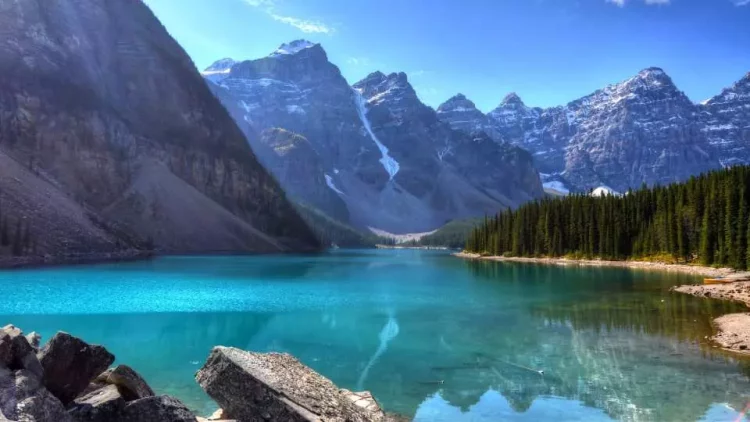The Rocky Mountains, or simply the Rockies, stretch more than 3,000 miles from northern Canada to New Mexico, creating one of the most majestic and diverse landscapes on the planet. This mountain range has captured the imagination of explorers, adventurers, and naturalists for centuries, offering a breathtaking view of rugged peaks, expansive valleys, pristine lakes, and diverse wildlife.
But what is it about the Rocky Mountains that has made them a symbol of natural beauty, adventure, and ecological significance? How do these mountains stand as not just a geological feature, but also as a cultural, ecological, and economic force shaping the history and development of North America?
In this article, we will dive deep into the Rocky Mountains’ geological history, examine the richness of its biodiversity, explore the cultural importance it holds for indigenous peoples and modern travelers, and analyze the challenges faced in preserving such a vast and varied natural wonder. From its towering peaks to its ancient forests, from world-renowned national parks to the recreation opportunities it offers, the Rocky Mountains are a treasure trove of natural splendor.
The Rocky Mountains: An Overview
Geography and Scope
The Rocky Mountains stretch across North America, from the northernmost regions of British Columbia in Canada all the way to New Mexico in the United States. These rugged mountains encompass various subranges, such as the Canadian Rockies, Colorado Rockies, and Wyoming Rockies, each of which has its own distinct characteristics.
- Length and Width: Spanning over 3,000 miles, the Rockies run from the Northern Rockies near the Canadian border to the Southern Rockies in New Mexico.
- Elevation: Some of the highest peaks in the Rockies exceed 14,000 feet, particularly in Colorado, where peaks like Mount Elbert (14,440 feet) and Mount Whitney (14,505 feet) tower over the landscape.
- The Continental Divide: The Rockies act as the Continental Divide of North America. Watersheds on the western slopes drain into the Pacific Ocean, while those on the eastern slopes drain into the Atlantic Ocean.
Major Mountain Ranges and Peaks
Some of the most famous subranges and peaks in the Rockies include:
- The Front Range (Colorado): Famous for towering peaks like Longs Peak (14,259 feet), this subrange is home to several major cities, including Denver.
- The Sawatch Range (Colorado): The home of Mount Elbert, the highest point in Colorado and the Rocky Mountains.
- The Canadian Rockies (Alberta/British Columbia): Featuring spectacular natural beauty, the Banff National Park and Jasper National Park are some of the most famous locations in this region.
- The Wind River Range (Wyoming): Known for rugged beauty and less-developed tourist infrastructure, this range is a haven for hikers and backpackers.
- The San Juan Mountains (Colorado): This area is famous for its beautiful alpine scenery and remote wilderness.
The Geological Formation of the Rockies
The story of the Rocky Mountains begins millions of years ago with the process of tectonic plate collision. Understanding the geology of the Rockies is crucial for appreciating the dramatic landscapes they present today.
- Pre-Rocky Mountain Formation: The land that would later become the Rockies was once part of the ancient Precambrian Shield, which formed over 3 billion years ago. During the Paleozoic and Mesozoic eras, the region was covered by shallow seas, and various sedimentary rocks accumulated.
- The Laramide Orogeny: The key event in the formation of the Rocky Mountains occurred during the Laramide Orogeny, a period of intense tectonic activity between 70 and 40 million years ago. During this time, the Pacific Plate collided with the North American Plate, causing the earth’s crust to buckle and fold, eventually resulting in the rise of the Rocky Mountain range.
- Modern Geological Features: The Rockies today exhibit classic features of an orogeny, including folded rock layers, faults, and basins. In addition, the movement of glaciers during the last Ice Age has carved out valleys, fjords, and cirques, contributing to the stunning visual appeal of the landscape.
Flora and Fauna: Biodiversity of the Rockies
The Rocky Mountains are home to an incredibly diverse range of ecosystems, from the lowlands to the alpine tundra. These ecosystems support a wide variety of flora and fauna, making the Rockies a hotspot for biodiversity.
Flora
- Forest Types: The lower slopes of the Rockies are dominated by coniferous forests, including species like ponderosa pine, spruce, fir, and Douglas fir. Higher elevations are home to alpine forests, and above the treeline, you’ll find tundra vegetation—small, hardy plants adapted to extreme weather conditions.
- Wildflowers: In the spring and summer months, the Rockies burst into color with a wide variety of wildflowers. From the iconic Indian Paintbrush to the Alpine Aster and Columbine, the flowers add an extra dimension to the region’s beauty.
- Endangered and Rare Plants: The high-altitude ecosystems also house rare and endangered plant species, such as the Rocky Mountain Green Gentian, and Sierra Nevada Snowbell, which exist only in small regions of the Rockies.
Fauna
The Rockies support an array of animal life, ranging from small mammals to large apex predators. Some of the most iconic species in the region include:
- Grizzly Bears and Black Bears: The Rockies are home to both grizzly and black bears, with sightings becoming a rare but prized experience for visitors. These apex predators play an essential role in the ecosystem by controlling the populations of herbivores and scavengers.
- Elk and Deer: Elk and deer are abundant in the Rockies, particularly in places like Rocky Mountain National Park. These animals are a crucial part of the ecosystem, providing prey for larger predators.
- Mountain Goats and Bighorn Sheep: High-altitude regions of the Rockies are home to mountain goats and bighorn sheep, which are well adapted to the rugged, rocky terrain.
- Birdlife: The Rockies host a diverse range of bird species, including the Golden Eagle, Peregrine Falcon, and Bald Eagle. These birds are especially important as apex predators in the region’s food chain.

Outdoor Activities and Recreation in the Rockies
The Rocky Mountains offer a wealth of recreational opportunities for nature enthusiasts, adventurers, and outdoor sports lovers. Whether it’s hiking, climbing, skiing, or wildlife watching, the Rockies cater to a wide range of outdoor activities.
Hiking and Backpacking
The Rocky Mountains boast hundreds of miles of hiking trails, from beginner-friendly paths to challenging multi-day backpacking routes. Some of the most popular trails include:
- The Continental Divide Trail: A 3,100-mile trail that follows the Continental Divide and crosses through the heart of the Rockies, offering incredible views and access to remote wilderness.
- Rocky Mountain National Park Trails: Located in Colorado, this park offers scenic routes such as Bear Lake and Emerald Lake, along with more challenging hikes like Longs Peak.
Rock Climbing and Mountaineering
For rock climbing and mountaineering enthusiasts, the Rockies are a haven. Areas like Colorado’s Flatirons, The Bugaboos in Canada, and the Wind River Range offer challenging and thrilling climbs. The region is also home to several renowned mountaineering expeditions, including Mount Elbert, the highest peak in Colorado.
Winter Sports
When winter arrives, the Rockies transform into a winter wonderland. Ski resorts like Aspen, Vail, Jackson Hole, and Banff offer world-class skiing, snowboarding, and snowshoeing experiences. The Rockies are one of North America’s premier winter destinations.
Wildlife Watching
With its diverse ecosystems, the Rockies provide exceptional wildlife watching opportunities. From moose and bears to birds and elks, the region offers numerous opportunities to observe these magnificent creatures in their natural habitat. Yellowstone National Park, Grand Teton National Park, and Banff National Park are some of the best places for wildlife viewing.
Conservation Efforts in the Rockies
Given the stunning natural beauty of the Rocky Mountains and the diversity of life they support, conservation has become a top priority. The region faces many challenges, including climate change, habitat loss, and human activity. Thankfully, there are several initiatives and organizations working tirelessly to protect this natural wonder.
- National Parks and Protected Areas: The U.S. and Canada have established national parks such as Yellowstone, Rocky Mountain National Park, and Banff National Park to protect large portions of the Rockies from development and exploitation.
- Conservation Organizations: Organizations like The Rocky Mountain Conservancy and The Nature Conservancy are actively working to preserve habitats and promote responsible tourism.
- **Climate
Change: One of the biggest threats to the Rockies’ ecosystems is the changing climate, which affects everything from glacial melt to species migration patterns. Efforts are underway to mitigate the impacts of global warming on the region.
Conclusion: Why Are the Rocky Mountains Such an Iconic Destination?
The Rocky Mountains are far more than just a mountain range. They represent the perfect synthesis of natural beauty, ecological importance, and outdoor adventure. From their ancient geological formations to their biodiversity and recreation opportunities, the Rockies are an unparalleled treasure. But perhaps their most significant role is as a symbol of the power and majesty of nature itself—a reminder of our connection to the natural world and the importance of its preservation.
Whether you’re a hiker, a climber, a skier, or simply a nature enthusiast, a visit to the Rocky Mountains will undoubtedly leave you awe-struck. It is a journey through one of the most magnificent landscapes on Earth, and for those who embrace its challenges and beauty, the Rockies will always be a part of their soul.





















